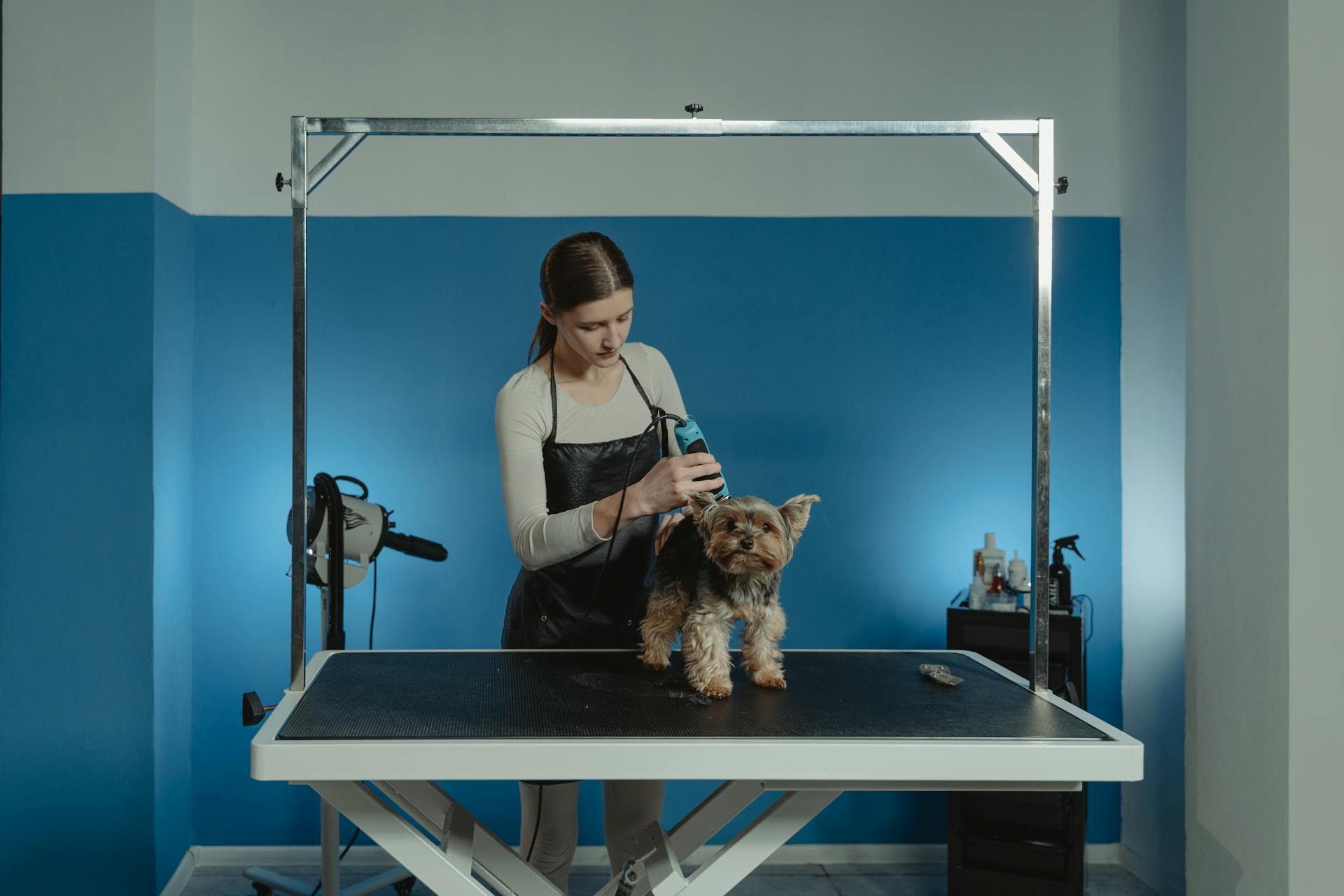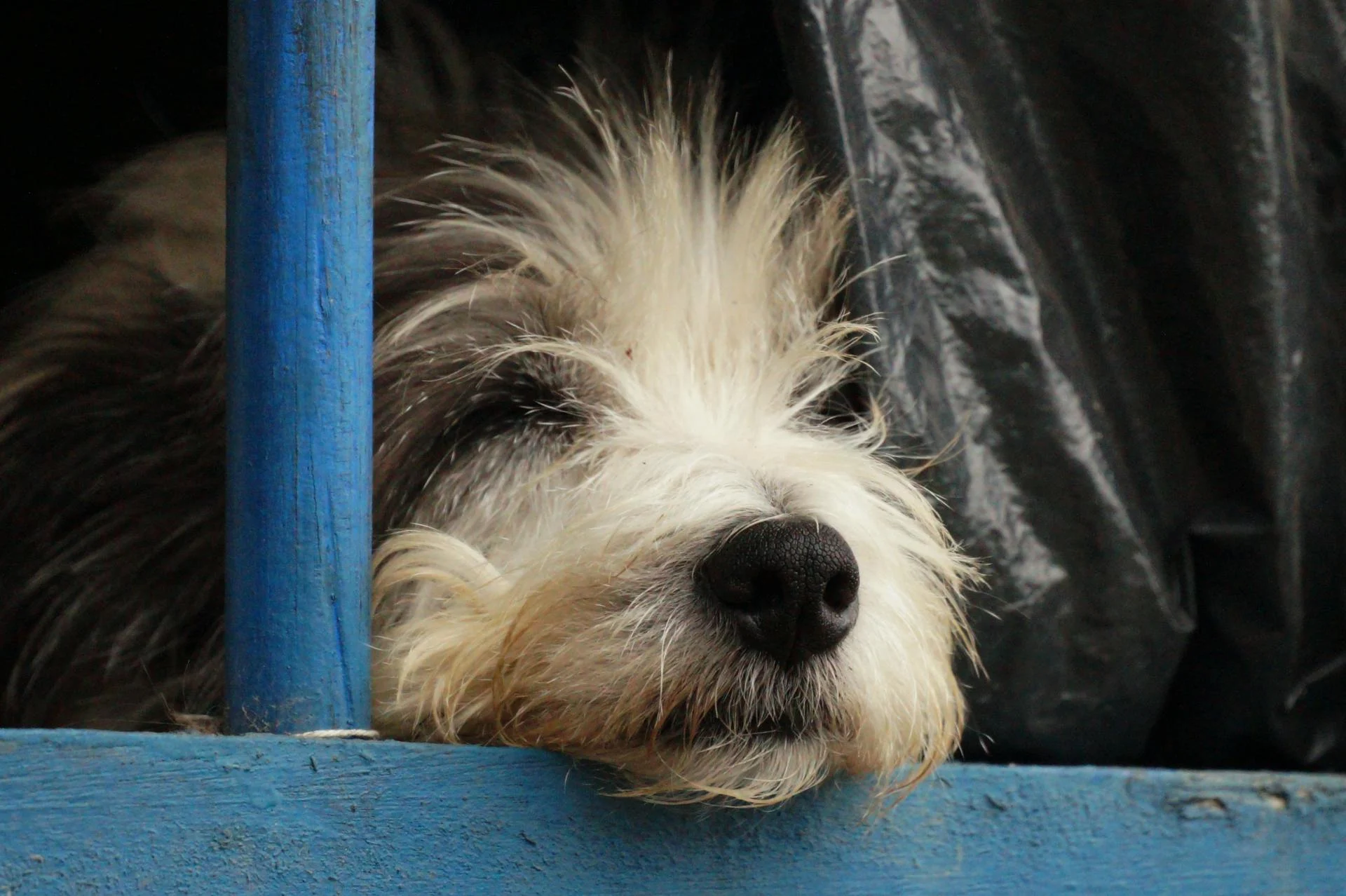
The Blue Teddy Roosevelt Terrier is a stunning breed that's sure to capture your heart.
They have a short, easy-to-maintain coat that requires minimal grooming, perfect for busy owners.
This breed is also known for being energetic and playful, making them a great companion for active families or individuals.
With proper exercise and training, they can thrive in a variety of living situations, from apartments to homes with yards.
Their small size, typically weighing between 10-15 pounds, makes them an ideal choice for city dwellers or those with limited space.
For another approach, see: Dogs Breeds That Start with B
Breed History
The Teddy Roosevelt Terrier breed has a rich history that dates back to the late 1800s, when they were brought to the United States by immigrants.
These small and sturdy hunters were originally bred to clear homes and farms of vermin, and they were especially skilled at this task. They were often described as a variety of Rat Terrier, with the Type B or short-legged group being known as the "Teddies" or Teddy Roosevelt Terriers.
Their ancestors include the Manchester, Bull, and Smooth Fox terriers, as well as the Beagle, Whippet, Italian Greyhound, and White English Terrier. This mix of breeds explains why Teddy Roosevelt Terriers can look quite distinct from the average Rat Terrier.
In the 1990s, some breed fanciers sought to separate the Type A and Type B Rat Terriers, leading to the development of a separate breed standard for the Teddy Roosevelt Terrier. The American Teddy Roosevelt Terrier Club was established to promote the breed.
The breed was recognized by the United Kennel Club in 1999 and by the American Kennel Club in 2016, when it was recorded in the Foundation Stock Service. Today, the Teddy Roosevelt Terrier is part of the Terrier Group designation and is also approved for Earthdog events.
Here's an interesting read: American Kennel Club Lancashire Heeler
Characteristics of the Breed
The blue Teddy Roosevelt Terrier is an energetic and playful breed that thrives on interaction and affection. They have a strong prey drive and will chase small animals, so it's essential to provide them with plenty of exercise and mental stimulation.
Their intelligence and loyalty make them easy to train, and they're highly trainable with positive reinforcement. They're also very smart, which means they can learn to adapt to almost any lifestyle.
Blue Teddy Roosevelt Terriers are naturally protective and territorial, but they're also great family dogs and wonderful friends to respectful children who handle them gently. They're generally dog-friendly and can get along with larger breeds.
Here are some key characteristics of the blue Teddy Roosevelt Terrier breed:
With their high energy levels and love for adventure, blue Teddy Roosevelt Terriers require regular exercise and mental stimulation to prevent boredom and destructive behavior. They're adaptable to almost any lifestyle, making them a great companion for home or farm.
Common Health Concerns
As a responsible owner of a Blue Teddy Roosevelt Terrier, it's essential to be aware of the potential health concerns that can affect your furry friend. Hip and elbow dysplasia are common issues in this breed, which can lead to arthritis and mobility problems if left untreated.
The Blue Teddy Roosevelt Terrier is also prone to patellar luxation, a condition where the kneecap slips out of place. This can be painful and may require surgery to correct.
Von Willebrand's Disease is another health concern that can affect this breed, causing excessive bleeding and bruising. Hypothyroidism, a condition where the thyroid gland doesn't produce enough hormones, can also occur.
Progressive Retinal Atrophy (PRA) and Dilated Cardiomyopathy (DCM) are two other health issues that can affect the Blue Teddy Roosevelt Terrier. PRA can cause blindness, while DCM can lead to heart failure.
If you're considering bringing a Blue Teddy Roosevelt Terrier into your family, it's crucial to work with a reputable breeder who has screened their breeding pairs for eye disease and other issues. Always ask about the health history of the parents and request a health guarantee to ensure you're getting a healthy pup.
Readers also liked: Teddy Roosevelt Terrier
Care and Grooming
The blue Teddy Roosevelt Terrier is a wonderful breed to care for, and with the right routine, you'll be well on your way to a happy and healthy companion.
They have a short coat that sheds moderately, but regular brushing can keep that to a minimum. Brushing their coat with a soft slicker brush every few days can help remove dead hair and debris.
Bathe your blue Teddy Roosevelt Terrier whenever it becomes dirty, which is usually every four to six weeks. Use a mild shampoo that doesn't strip away natural oil or irritate the skin.
Dry your dog thoroughly after bathing to prevent skin irritation. This is also a good time to check their ears and trim their nails, as their nails have a tendency to overgrow and crack or split.
Brushing your blue Teddy Roosevelt Terrier's teeth is crucial, as they are prone to dental disease. Brush their teeth every other day or so to keep their teeth clean and healthy.
Their nails need to be trimmed every two weeks to prevent overgrowth, and their ears should be inspected weekly for redness, debris, or odor. If their ears become dirty, clean them with a pet-safe ear cleaner, and make an appointment with your veterinarian if they look inflamed or have excessive discharge.
Check this out: Black Mouth Cur Teeth
Exercise and Training
Exercise is key for blue Teddy Roosevelt terriers. They need daily walks or hikes, but you can also try swimming, vigorous games of fetch or Frisbee, or even training for a competitive dog sport like agility or flyball.
Make sure to keep your blue Teddy on a leash when you're out and about, as their instinct to chase and hunt small creatures is strong and can cause them to run out into traffic.
Providing approved digging spots in the yard can help keep your blue Teddy occupied and prevent unwanted digging. Try using a child's sandbox filled with sand or soil, and even secretly burying treasures like treats, chews, and toys for them to find.
Exercise
Teddy Roosevelt terriers are built for action, requiring daily exercise to keep them happy and healthy. They thrive on physical activity, making them perfect for families who love the outdoors.
A daily walk or hike is a great place to start, but don't be surprised if your Teddy wants more. They have a strong instinct to chase and hunt small creatures, which can sometimes get them into trouble.

Swimming is an excellent way to burn off energy, and many Teddy Roosevelt terriers love the water. Vigorous games of fetch or Frisbee are also a great way to get them moving and engaged.
Make sure to keep your Teddy on a leash when you're out and about, as their instinct to chase small creatures can cause them to run into traffic.
Training
Training your Teddy Roosevelt terrier is a breeze, as they're smart, curious, and eager to please.
Keep training upbeat, fun, and positive, using treat or toy rewards and plenty of praise.
They love to dig, so provide approved digging spots in certain areas of the yard to keep them occupied and your home vermin-free.
You can even use a child's sandbox filled with sand or soil for them to dig in.
Secretly burying treasures like treats, chews, and toys will keep them engaged and excited to dig.
Diet and Nutrition
Feeding your Blue Teddy Roosevelt terrier is crucial to maintaining their overall health and energy levels.
Serving measured amounts of age-appropriate dog food twice a day is essential to prevent overfeeding.
Free feeding can lead to excess weight gain, which puts a strain on their joints and back, and causes other health problems like diabetes.
Some very active Blue Teddies may need more food to fuel their bodies.
Talk to your veterinarian or breeder for advice if you're unsure how much to feed your dog.
Buying and Adopting
The blue Teddy Roosevelt terrier is a rare breed, so finding a breeder can be a challenge. Be prepared to get on a long waitlist if you're looking to buy from a reputable breeder.
If you're unable to find a breeder, you may want to consider adopting a blue Teddy Roosevelt terrier or a mix. Some of these dogs may end up in local animal shelters or become available through private rescue groups.
Getting on a waitlist can be frustrating, but it's worth it to ensure you're getting a healthy puppy from a responsible breeder. The American Kennel Club provides a list of member breeders on its website, which is a great place to start your search.
Overview and Fun Facts
The Blue Teddy Roosevelt Terrier is a fantastic breed for families. They're great family dogs.
These little guys are affectionate and engaging, making them a joy to be around. They're also kid-friendly and dog-friendly, which is a big plus for families with multiple pets.
However, they do have some needs that you should be aware of. They may dig up the yard, so be prepared for some landscaping work.
To keep your Blue Teddy Roosevelt Terrier happy and healthy, they need lots of exercise. This is essential to burn off their energy and prevent destructive behavior.
One thing to keep in mind is that they have a high prey drive, which means they're not safe off-leash. This is crucial to remember when you're out on walks or in areas with wildlife.
Here are some key characteristics to consider:
- Great family dog
- Affectionate and engaging
- Kid-friendly and dog-friendly
- May dig up the yard
- Needs lots of exercise
- High prey drive/not safe off leash
Personality
The Blue Teddy Roosevelt Terrier is a unique breed with a distinct personality. They are known for being energetic and lively, always ready for action.
Their friendly and outgoing nature makes them great companions, always eager to play and have fun. They are also known to be fiercely loyal and protective of their family.
Despite their tough exterior, they have a soft spot for snuggles and affection, making them perfect for families with children. They are also highly intelligent and trainable.
Their short coats require minimal grooming, but they do need regular exercise to keep them happy and healthy.
Frequently Asked Questions
How much does a Teddy Roosevelt Terrier cost?
Our Teddy Roosevelt Terriers typically cost $525, but prices may vary due to individual circumstances.
What breeds make up a Teddy Roosevelt Terrier?
The Teddy Roosevelt Terrier is believed to be a cross between several breeds, including the Manchester Terrier, Bull Terrier, Smooth Fox Terrier, Beagle, Whippet, and Italian Greyhound, with possible involvement of the White English Terrier. This unique mix of breeds contributes to the Teddy Roosevelt Terrier's distinctive characteristics.
Are Teddy Roosevelt Terriers good dogs?
Teddy Roosevelt Terriers are friendly, affectionate dogs that thrive with family, but may require extra attention and socialization. They can make great pets for active families with children and other pets, but may not be ideal for everyone
What is the life expectancy of a Teddy Roosevelt Terrier?
Teddy Roosevelt Terriers typically live for 13 to 16 years, influenced by factors such as exercise, diet, and genetics. With proper care, they can enjoy a long and healthy life.
Sources
- https://simplyfordogs.com/breed-spotlight-teddy-roosevelt-terrier/
- https://www.akc.org/dog-breeds/teddy-roosevelt-terrier/
- https://en.wikipedia.org/wiki/Teddy_Roosevelt_Terrier
- https://www.thesprucepets.com/teddy-roosevelt-terrier-dog-breed-profile-5183664
- https://embarkvet.com/resources/dog-breeds/teddy-roosevelt-terrier/
Featured Images: pexels.com


